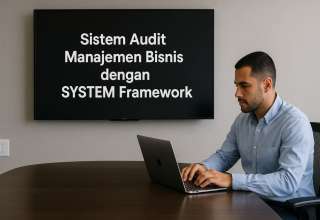
SYSTEM Framework: A Strategic Foundation for Technology-Based System Development
By: Mohamad Haitan Rachman, INOSI
Please use The SYSTEM Builder GPT: https://chatgpt.com/g/g-6857336737c48191baed5baede8b390d-system-builder-gpt
In today’s rapidly evolving digital era, organizations, institutions, and individuals need a framework that can holistically integrate structure, outcomes, strategy, technology, empowerment, and management. The SYSTEM Framework is designed to meet that need. The word SYSTEM is an acronym for:
- S – Structured
- Y – Yielding
- S – Strategic
- T – Technology
- E – Empowered
- M – Management
This framework serves as a guide to building systems that are not only efficient and effective but also adaptive to change and capable of driving sustainable growth.
1. S – Structured
The first component, Structured, emphasizes the importance of organization in system design and implementation. A well-built system must have a solid foundation, logical workflows, comprehensive documentation, and standardized rules that ensure sustainability.
In this context, structure includes:
- Modular system architecture, making it easy to maintain and scale.
- Standardized work procedures to ensure consistency.
- Documented business processes and system workflows, enabling shared understanding.
- An organizational structure that supports system governance, from top-level management to technical teams.
Without clear structure, systems become prone to confusion, inconsistency, and eventual failure.
2. Y – Yielding
A great system must not only be well-structured but also deliver measurable results. The Yielding component focuses on being result-oriented — whether that means efficiency, productivity, user satisfaction, or achievement of strategic goals.
Key principles include:
- Using KPIs (Key Performance Indicators) as performance benchmarks.
- Implementing feedback loops to assess effectiveness and refine continuously.
- Creating value for users and the organization.
- Tracking outcomes, connecting system activities to tangible results.
A yielding system is more than operational—it is a strategic engine that generates impact and value.
3. S – Strategic
A system should not exist in isolation. It must be aligned with the long-term vision, mission, and strategy of the organization. This is the essence of the Strategic component. A system isn’t merely a tool — it’s a driver of strategic transformation.
Strategic alignment in the SYSTEM Framework includes:
- Direct linkage to organizational strategic plans.
- Leveraging data and insights to support decision-making.
- Long-term thinking in system development and maintenance.
- Capacity to adapt to changing markets and technologies.
With a clear strategy, systems can lead change and become a competitive advantage.
4. T – Technology
In the digital era, technology is the heart of any system. The Technology component focuses on leveraging modern tools to enhance functionality, security, scalability, and innovation.
Essential aspects include:
- Automation and business process integration.
- Utilization of cloud computing, AI, and IoT for optimization.
- Cybersecurity and data protection protocols.
- Technology that fits real user needs.
The SYSTEM Framework does not promote “technology for technology’s sake,” but emphasizes relevant, functional, and impactful application of technology.
5. E – Empowered
A system is only as strong as the people who use it. The Empowered component highlights the need to develop users who understand, utilize, and even help improve the system.
Empowerment includes:
- Training and capacity building for users.
- User involvement in the design process.
- Easy-to-understand documentation and support resources.
- A culture of innovation and digital literacy.
An empowered system fosters ownership, collaboration, and engagement across all levels of an organization.
6. M – Management
Without effective management, systems lose direction and control. The Management component ensures that all aspects of the system are designed, operated, monitored, and evaluated professionally and sustainably.
Key management elements include:
- Clear governance and system policies.
- Planning, execution, monitoring, and system evaluation.
- Risk management and service continuity planning.
- Project management in system development.
Good management practices are critical not only during development but also in system maintenance, updates, and future enhancements.
Key Advantages of the SYSTEM Framework
- Holistic and Integrated – Combines technical aspects (structure, technology) with human dimensions (empowerment, management).
- Adaptable – Applicable to various sectors including education, government, business, and tech startups.
- Strategic Alignment – Ensures systems are tied to long-term organizational goals.
- Result-Oriented – Focuses on achieving measurable results, not just technical completion.
Real-World Applications of the SYSTEM Framework
Example 1: Educational Management Information System
- Structured: Curriculum and academic administration are digitally documented.
- Yielding: Reduced enrollment processing time and increased student satisfaction.
- Strategic: Supports the 2030 digital campus vision.
- Technology: Cloud-based application with real-time dashboards.
- Empowered: Teachers and staff receive regular training.
- Management: A system admin team guided by standard operating procedures (SOPs).
Example 2: Startup Innovation Management System
- Structured: Innovation roadmap from idea to product.
- Yielding: More products reaching the market.
- Strategic: Supports a five-year market development plan.
- Technology: Collaborative digital platform for co-creation.
- Empowered: Mentors, developers, and users actively contribute.
- Management: Agile project management for product iteration cycles.
Conclusion
The SYSTEM Framework is not just an acronym—it is a thinking and action model that can be practically applied to build systems that are robust, impactful, and future-focused. In the face of digital transformation challenges, a system that is well-structured, result-driven, strategically aligned, technologically sound, user-empowered, and professionally managed is the key to sustainable success.
This framework serves as a foundational tool for planning new systems, evaluating existing ones, and guiding technology-based organizational development.
With the SYSTEM Framework, we’re not just building systems—we’re building the future.!
If you have questions related to writing, designing, developing, and training systems and wish to collaborate, please contact us at haitan.rachman@inosi.co.id.










